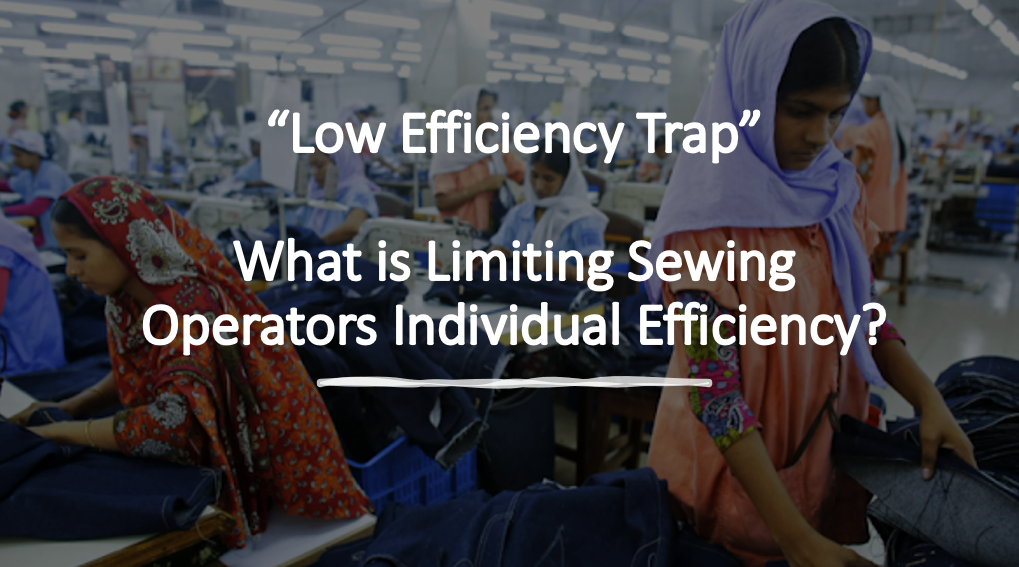In this post I have shared the observation of Dr. Prabir Jana regarding the low performance of the sewing operators in the garment manufacturing sector. He has posted this note on the LinkedIn page. I have re-published the same note here after getting his permission.
The purpose is to share these facts and ideas with a bigger audience. This will help you check if the same trap exists in your company, and you have yet to be made aware of it. If it exists, then how do we come out of this trap.
Post on LinkedIn page:
Dr. Jana has written this -
India, Bangladesh, Vietnam is home to contract manufacturers for global brands. Over the last three decades many studies have been reported about the low efficiency of sewing workers in this region. In fact, it is a standard practice to take 55-65% of PMTS time standards (GSD/ProSMV/timeSSD/SewEasy/etc.) as achievable targets across sewing factories in the Indian subcontinent.
I remember during the 90s the noted consultants from KSA mentioned that. A recent post by Joachim Hensch Consulting mentioning the same trend in Indian and Bangladeshi industry prompts me to write this post. Why are our sewing workers less efficient?
Why could we not improve our sewing worker’s efficiency during the last three decades?
Actually, we are in a low efficiency trap due to faulty HR policy.
In any sewing line (where division of labour is followed), each sewing worker is supposed to excel in only one sewing operation. When a trainee operator joins a factory, he/she can perform one operation and is considered the lowest grade worker (lowest salary). Over the years as the worker learns more and more operations (multi-skill operator), his/her grade increases (earns more). For the lure of higher grades each and every sewing worker is encouraged to learn more and more operations, rather than excelling in one operation.
Imagine a scenario, where a sewing worker who can do two operations at 90% each will be at a lower salary grade than a worker who knows five operations, all at 55-65% efficiency. There is no incentive to become a 90% efficient worker. While common sense tells us you can only be “jack of all trades” but “master of none”.
We are creating factories full of sewing workers who can do operations (typically more than 5) in the range of 55-65% efficiency, but none who can do two operations at 90% each. Until the existing grading policy changes, we will remain in this low efficiency trap.
Here is original post on LinedIn:
Comments from the readers and industry experts
On the above post, many industry experts shared their comments on the LinkedIn page. You can read that here.
He added comments on the above post and explained a few points.
My last post about "Low Efficiency Trap" generated unprecedented response from people across continents. I have tried to reply individually but lost track as there are too many to reply to. There were some misinterpretations of "efficiency", I was mentioning about individual operator's efficiency (or rating of operator, to be more precise).
Simply put, one individual worker can have very high rating (90% and above) only in few skills (say up to 3) skills. The moment one individual starts learning more skills (say 3 and above), his/her rating will start dropping and he/she will become "multi-skilled". This is human limitation! Hope you understand that the number 3 is and indicative.
My message was not against "multi-skill", but to change the grading policy which is biased towards multi-skill only. For example, organizations should consider giving a sewing worker (who can do only two skills each with 100%) same grade with someone who can do 4 different skills at 50%. Thank you all for your passionate contribution towards building a better place for manufacturing.
My Observations:
I agree with Dr. Jana on his observation and analysis. The cause of ‘low operator efficiency’ due to HR salary structure may be true in most of the garment factories but there are other reasons as well which are causing low efficiency of the operators. The volume of ‘Low efficiency’ operators exists not only due to individual operators’ sewing skill and efforts. The ‘low efficiency’ is built and controlled by floor managers and many other factors.One is the HR policy that is mentioned by Dr. Jana.
Other factors are:
#1. Factories are only measuring the overall efficiency of the operators and publish their operator’s performance levels. They do not measure the on-standard efficiency of their operators. Overall efficiency includes all the non-productive times including line setting, style changeover, no work supply to the line, etc. If on-standard efficiency is measured and analyzed accurately that would be at least 20% higher than the overall efficiency of the individual operators.
#2. Sometimes excess number of sewing operators are assigned to the line. When the same workload is distributed among excess operators in a line there is no way operators can show higher efficiency.
#3. No performance bonus – Having no performance bonus for the operators is also one of the reasons of low-efficiency operators in factories.

